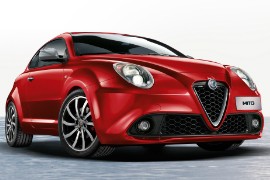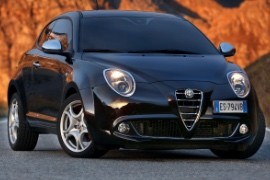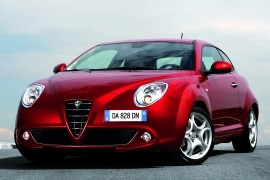ALFA ROMEO MiTo Models/Series Timeline, Specifications & Photos
First production year: 2008
Engines: Gasoline, Diesel, Natural gas
Body style: Hatchback
Alfa Romeo MiTo entered its seventh year on the market and went through a facelift in 2013, but the aging model started to show its wrinkles, so the Italian automaker decided to refresh it once again.
The Italian automaker built the MiTo on the same platform as the Fiat Grande Punto and the Opel Corsa. That decision may not have been the most preferred solution for the "alfisti" (the Alfa Romeo fans). Still, the automaker actually made a lot of money because of it. Moreover, the sales for this supermini hatchback were still good. Hence, the car manufacturer decided to facelift it again for the 2016 model year. The car was unveiled at the Geneva Motor Show, and sales started soon after. Alfa Romeo didn't radically restyle its supermini hatchback, but it still offered it in three grades and made it available with nine colors and a wide choice of wheels ranging between 16 and 18 inches. There were also some changes to the interior, including an updated infotainment system.
Alfa Romeo's design team couldn't resist adding a few new touches to the car's front. As a result, it changed the mesh grille that adorned the Alfa shield and the lower side scoops. While its predecessor featured chromed horizontal slats, the 2016 model year had a hexagonal pattern instead. But still, on the lower part of the bumper, the automaker kept the round fog lamps.
From its profile, the three-door hatchback boasted contrasting door mirror caps and handles, plus a new design for the wheels. Customers could also choose larger wheels, even for the lower grade versions, not just for the potent Quadrifoglio Verde (four cloves). The dark B-post and the frameless windows for the front doors were still something special on the market since only the MiTo and the MINI hatchback had that feature. Alfa Romeo also slightly updated the car's look from behind, which sported new LED taillights with burnished surroundings.
Inside, customers were greeted by a well-built cabin fitted with high-bolstered front seats. As an option, they could get a set of Seabelt sports seats with integrated headrests. Fronting the driver was the same binocular-styled instrument cluster featuring large dials for the speedometer and rev counter and smaller gauges for the fuel level and coolant temperature. The center console housed the switch for the DNA drive mode selector and the gear stick. On the center stack, the Italian automaker added the 5-inch touchscreen of the infotainment system. Customers could connect to it via a dedicated app, which was available in the Apple Store or Google Play Store. That app, named Uconnect LIVE, allowed them to get more than 35 million songs. Thanks to the Internet connection via mobile phone, the car could also connect to over 100,000 online radio stations. In the back, the split-folding (60/40) bench seat could hardly accommodate more than two people.
Under the hood, Alfa Romeo kept a choice of three gasoline engines, two turbodiesel powerplants, and one fueled by CNG. The automaker also offered customers the option to get a six-speed TCT (dual clutch) automatic gearbox that sent its power to the front wheels only.
Six years after it introduced the MiTo lineup in its portfolio, Alfa Romeo refreshed its smallest-sized hatchback and gave it a smaller engine and a slight visual update.
During the world financial crisis, most automakers suffered greatly. Alfa Romeo was also shattered, but it managed to dodge the bankruptcy bullet, unlike other big names in the industry. One of the reasons was the MiTo. This supermini vehicle was affordable, and those who craved a better-styled vehicle than any other mundane cars on the road could get it. At the same time, Alfa Romeo and Fiat engineers tried to create fuel-efficient engines, and one of them was the so-called Twin-Air unit that won the "Engine of the Year" award in the one-liter category. As a result, Fiat, Alfa Romeo, and Lancia installed it under the hoods of their small vehicles, such as the Grande Punte, the MiTo, and the Ypsilon, respectively. Alfa Romeo also improved its little hatchback to make it more appealing to those customers who dared to be different and show up with something other than an economy box on wheels.
The MiTo featured a fresh front fascia with chromed horizontal slats on its grille. Furthermore, on the lower bumper, the automaker added some shiny bits around the air intake to give the vehicle more personality. In addition, the trim around the headlights featured a burnished finish. Depending on the grade, the automaker provided it with round fog lamps integrated into individual clusters that flanked the apron.
With a profile that couldn't be upgraded too much due to production costs, the MiTo preserved most of the parts, and that included the frameless windows for the doors. That was a unique feature in the segment. Alfa Romeo also provided customers an option for chromed door mirror caps and handles, which contrasted better if they were applied to the bodywork's black or dark red colors. At the back, the automaker added the same burnished finish around the round taillights that flanked the tailgate.
Alfa Romeo also improved and updated the interior. Customers could opt for a new infotainment system developed together with Continental. It was available with the TomTom navigation system and included an advanced Bluetooth connection that allowed SMS text message readings via text-to-speech function. Furthermore, the 5-inch touchscreen allowed customers to select their desired music from their iPods connected to the system via a USB port. They could also use a regular MP3 player via an Aux-in, 3.5-mm jack. Besides this technological upgrade, the Italian automaker added distinctive dashboard designs depending on the grade.
But Alfa Romeo didn't just update the MiTo's look. It also worked under the hood. There, it installed the award-winning two-cylinder Twin-Air engine. This pocket-sized, 0.9-liter turbocharged powerplant featured advanced technologies that lower the fuel consumption. It also provided enough torque and power to make the supermini a practical in-city vehicle. The MiTo's engine lineup also consisted of other gasoline or turbodiesel units, which could provide customers enough energy for their daily activities.
Introduced in 2008 as an urban premium hatchback, the MiTo took its name from the cities of Milan and Torino and tried to impress customers with an upmarket styling based on a mundane platform shared with the Fiat Grand Punto and Opel/Vauxhall Corsa.
When Fiat and GM tried to join forces, they developed a new platform named GM Fiat Small platform. Unlike the American automaker, who didn’t have a premium brand based in Europe, Fiat had the Alfa Romeo. So, it decided to create an elegant urban car, and the result was the MiTo. While it was pricy for small-sized vehicles, it was an affordable premium hatchback that could provide more luxurious items than most other cars in the segment. In its ten-year production run, Alfa Romeo sold about 300,000 units of the MiTo. It wasn’t a stunning success, but at least it could bring some money for the company.
At the front, the MiTo featured a front fascia that resembled the sporty and expensive 8C Competizione and Spider. Its headlights sported a triangular shape flush to the front fenders and were surrounded by chromed trims. The tri-lobo concept, where the tall triangular Alfa Romeo crest was flanked on the lower side by horizontal slats, looked similar to other products from the premium Italian automaker, including the 159 sports sedan. Finally, the hood featured a V-shaped power dome that started from the lower side of the Alfa Romeo shield and continued to the A-pillars’ bases.
Alfa Romeo made the MiTo exclusively as a three-door affair, unlike the Grande, which was available in a three-door configuration as well. The slightly enlarged front and rear fenders gave the car a sporty look, while the chromed door handles looked upscale. Alfa Romeo decorated the lower side of the windowline with a chromed trim, creating a unique, luxurious image for the vehicle. Finally, at the back, the carmaker installed corner-mounted round taillights with chromed surrounding. At the lower side of the bumper, the MiTo sported chromed exhausts.
Inside, most cars in this segment came with cloth upholstery and didn’t offer leather seats. The MiTo did, so it looked more special. The driver fronted a compact instrument cluster with large dials for the speedometer and tachometer and small gauges for the coolant temperature and fuel level. In addition, the automaker added a small monochrome display on the dash panel. The high-bolstered front seats provided good side support, while at the back, Alfa Romeo installed a bench seat profiled for two. The MiTo was available in three grades: Turismo, Lusso, and Veloce.
Under the hood, Alfa Romeo installed a choice of turbo diesel and gasoline engines that sent their power to the front wheels via either a five or six-speed manual gearbox or a six-speed automatic, depending on the engine option. Power ranged between 85 PS (84 hp) and 135 PS (133 hp) and was sent to the front wheels.


